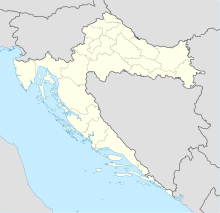Narona
Coordinates: 43 ° 2 ′ 47 " N , 17 ° 35 ′ 55" E
Narona was an ancient trading town and Roman colony in ancient Dalmatia . In the early Middle Ages the city was destroyed and abandoned. The Roman Catholic Church awards Narona or the title episcopus Naronensis as the titular diocese .
location
The remains of the ancient city of Narona are in Vid , a village about 4 km west of Metković . The city was located on a mountainside 58 m above sea level, directly on the Neretva River , which is navigable from its mouth up to Narona.
history
Little is known about Narona from written sources. Pseudo-Skylax mentions the city as a Greek emporion (trading center), where imported Greek goods were sold to the Illyrian hinterland.
Most of the information about the city came from excavations: the inhabitants of Narona were Greek colonists and Hellenized Illyrians. Presumably they laid the city around 400 BC. Chr. The oldest fortifications found, two round towers on the hilltop, date from the 4th century BC. The city remained unfortified from the eastern side, as the Neretva offered natural protection. During the 2nd century BC In BC Narona came into the interests of the Romans. In 156 BC In the year 135 BC, Narona served the Roman army under the leadership of Gaius Marcius Figulus as a base. An army of Servius Flaccus. In the 1st century BC The city walls were extended to the road that led from Salona to Narona. After the conquest of Narona by Octavian in 33 BC. Chr. The city was a Roman colony and the population grew sharply. In Roman times a forum, various temples, thermal baths and probably also the theater were built. At the time of the Marcomannic Wars (166–180 AD), the fortifications were renewed.
The city probably existed until the 7th century, which is proven by money and jewelry finds from this time. The latest research suggests that the city will exist for an even longer period.
Excavations
The first systematic excavations were carried out at the end of the 19th century by the Austrian archaeologist Carl Patsch . He identified the location of the forum and the city walls and found a number of coins, amphorae and inscriptions. After the Second World War , experts from the Split Archaeological Museum carried out new excavations. They discovered a mosaic near the forum. In 1978 Cambi found a white limestone head of the Roman emperor Vespasian from the year 75 AD. Further excavations took place from 1991 to 1997 under the direction of Emilio Marins (* 1951). The foundations of the early Christian basilica, which are located under today's Church of St. Vitus, have been examined and a well-preserved baptismal font has been found. An Augustus temple from the 1st century AD was brought to light on the forum . Sixteen statues of the family of Augustus as well as of Roman officials and deities were found who - presumably in the 4th century at the time of the establishment of Christianity as the state religion - were beheaded and toppled from their pedestals. Today, the Narona Archaeological Museum is located here, which exhibits around 900 other finds in addition to the reconstructed statues.
Numerous stone finds were incorporated into house facades as ornaments by the residents of Vids.

Late antique and early medieval weapons, including five helmets, were also discovered in Narona. It is evidently found in a depot, i.e. leftovers that were once deliberately hidden there and later fell into oblivion. The helmets are two Baldenheim type helmets (St. Vid / Narona I and II), a Deir el-Medina / Leiden type helmet (St. Vid Narona V.) and two iron band helmets (St. Vid Narona III. And IV.), Which were in the Baldenheim Spangenhelm I. The finds are now in the Kunsthistorisches Museum Vienna .
See also
literature
- Marc Mayer: La sociedad de la Narona romana. In: Gianpaolo Urso (ed.): Dall'Adriatico al Danubio. l'Illirico nell'età greca e romana. Atti del Convegno internazionale, Cividale del Friuli, 25–27 September 2003. (= I convegni della Fondazione Niccolò Canussio . 3), Pisa 2004. ISBN 88-467-1069-X . (PDF file; 2.54 MB)
- Emilio Marin (ed.): Arheoloska istrazivanja u Naroni i Dolini Neretve. (= Izdanja Hrvatskog Arheoloskog Drustva 22), Zagreb 2003. ISBN 953-98743-9-4
- Emilio Marin: Corpus inscriptionum naronitanarum. Macerata 1999. ISBN 88-8147-150-7
- Carl Patsch: On the history and topography of Narona. (= Writings of the Balkan Commission of the Imperial Academy of Sciences, Antiquarian Department 5), Vienna 1907.
- Carl Patsch: Smaller investigations in and around Narona. In: Jahrbuch für Altertumskunde 2, 1908, pp. 87–117.
Individual evidence
- ↑ Mahand Vogt: Spangenhelme. Baldenheim and related types. Monographs of the Römisch-Germanisches Zentralmuseum 39. Römisch-Germanisches Zentralmuseum, Schnell & Steiner, Regensburg 2007. ISBN 978-3-7954-2006-2 .


